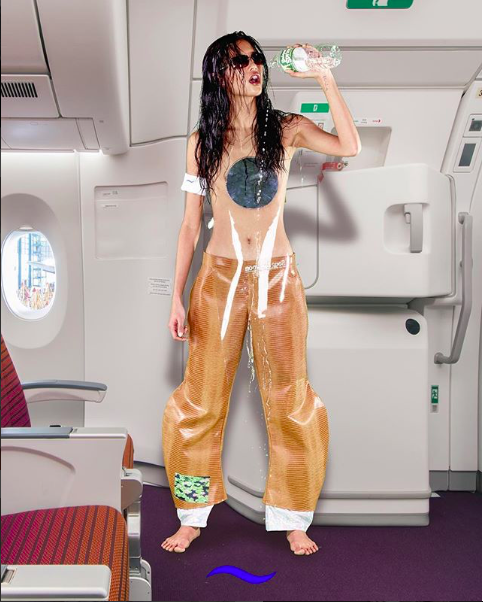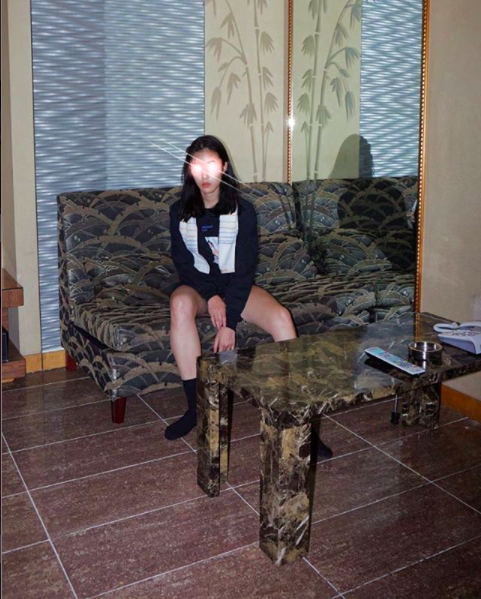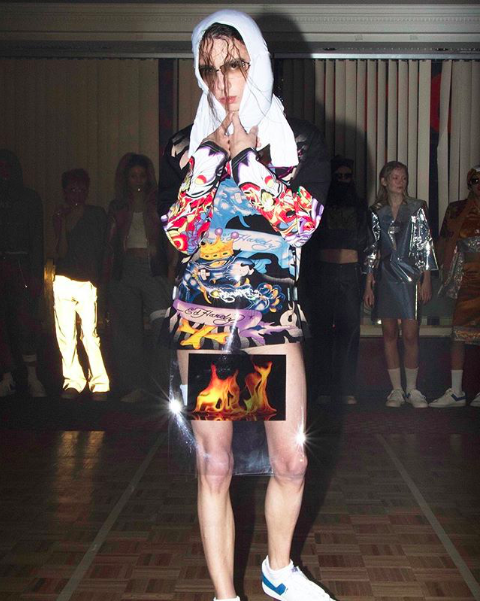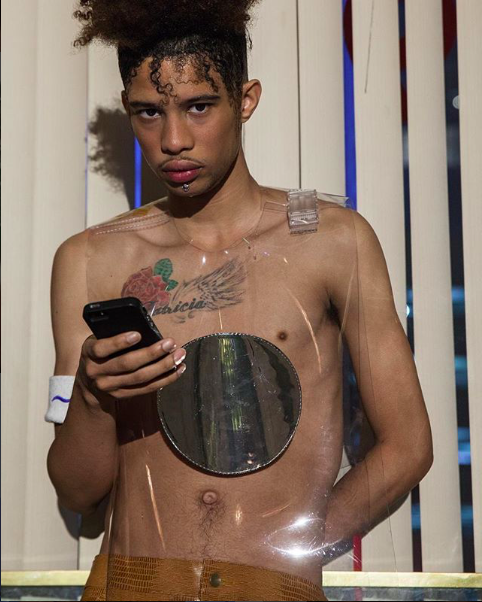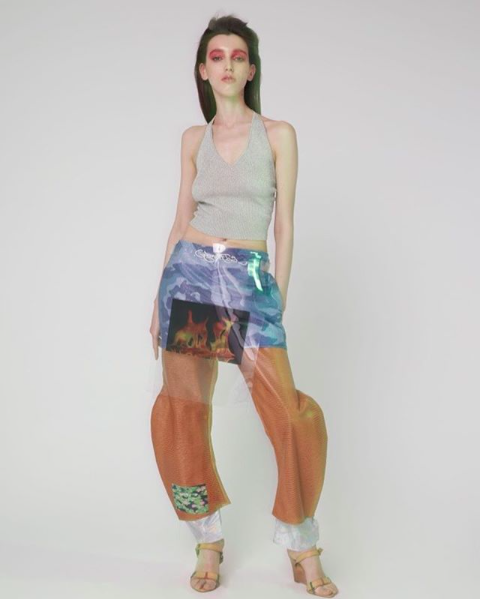https://cools.com/song-seoyoons-ever-changing-identity/
Far away from home, amongst trees and the silence of a foreign tongue, Song Seoyoon was filling out her Parsons application. Having left Korea at the age of 16 to attend high school in upstate New York, the pillars of her youth held her up as a New Yorker. Song had always known that she wanted to be a designer, sourcing divine inspiration from her affinity for painting, drawing and culture. Upon acceptance to Parsons and the more she learned about the industry, the less enchanted she became. Deciding finally to take a hiatus, Song backed away from hemlines and the intricacy of stitching to pursue a career in fine art, at least until Nike (literally) jogged her memory as to what kind of power this “whole fashion thing” indiscreetly held.
It was an unassuming morning at Union Square, tourists bustled by, the voices of the Hare Krishnas lifted above the smell of burnt incense, and Song has just caught the L train nine stops in from where she lived in Bushwick. Everywhere she turned she saw the infamous swoosh. Whether it was worn by a fuc*boy in Huaraches or a 70-year-old OG with a full head of white hair sporting Air Force Ones, Song realized that fashion, as superficial as it might be, was our second skin. It allowed us to exist in society and vice versa. Her “aha” moment had come and she returned to Parsons with an attitude that hollered “Just do it”.
With style eons away from Gangnam, Song would go on to graduate from Parsons and win the VFiles Runway Season 7. Her design process is a cultural conversation that intertwines couture with the avant-garde surrealism of the internet. From plastic-coated dresses that seem to allude to unwrapped Barbie dolls in their packaging, to monogram Gucci-esque tracksuits, to patent outerwear printed with tattooed bodies, Song understands fashion to exist for the people. Her designs transcend artistic expression and instead serve as a mirror for the ongoing dialogue of the ever-changing present. COOLS chatted with the designer from her home in Korea about the “masturbation” of the fine art world, the beauty of a wavering identity, and her recently completed SS18 collection.
COOLS: Hey, Song what time is it there?
Song Seoyoon: Hey. It’s 10 in the morning [laughs]
COOLS: Oh my god! Well, diving right in during that year off that you took from attending Parsons, what realizations did you come to about the world of fine art in relation to the world of fashion and vice versa?
SS: So before I took a year off and decided that I didn’t want to do fashion, I thought fashion was a medium of art. But I realized that fashion is not really about art -- I mean there are some artists like Rei Kawakubo or [Martin] Margiela in the industry but mostly fashion exists for culture I think.
COOLS: What do you mean by culture?
SS: So, to me, fashion is not so much about clothing or expression of your artistic mind.
Fashion is more about the moment right now. The moment changes every second and every second is different in the whole history and that I think this is called, “culture.”
Culture exists when and because human beings exist. I tend not to focus on my personal or individual ideas because I think art is mostly about masturbation almost, it’s a selfish action and I think fashion should exist for the people of the now so I should never be lazy about not knowing what’s going on in the world. It’s all about the trend, it’s all about the youth, the people, what they want at that very moment of this changing flow.
COOLS: It’s interesting too because you say it’s not about expression, but then how does expression tie into all of this because inevitably, it’s there. You’re experiencing the world through your own perspective and filter.
SS: Right, right. So in terms of designs, I try to go on the visual trend of what’s happening right now, not necessarily in terms of fashion design but more so about visual inspiration that people share on Instagram or other social media outlets. In terms of concepts, I go with what I read or what I’m studying at the time and it might not be trendy at the moment but since it’s a concept, it doesn't really have to have the cool interpretation I guess.
COOLS: I know you reference things like Buddhism and other abstract concepts in your work — so really a lot of it too is your own interpretation of these concepts. How do you bring such abstractions to life?
SS: I don’t necessarily sit down and think and try to imagine things that I’ve read, it’s more like I just live with those ideas. I constantly stumble on visual things on the internet; I read a lot of books, picture books, everything, and as I go on researching those images without knowing what I want to get, I randomly save certain images that look like it’ll go with my conceptual ideas. I have a whole collection of these references, and when I decide to make a collection, out of nowhere I can imagine and go back to the references I’ve already collected and inspiration suddenly comes into me that relates to the concept that I was going to make for the collection.
COOLS: In the industry today, designers are expected to put out at least two collections a year, do all these cruises, and all this other bullshit, and for you, it really sounds like you’re simply creating from a place that mirrors your understanding of a cultural conversation. How do you see yourself fitting into the “world of fashion”?
SS: Yeah, it’s very different for me, and I actually don’t know if I could do that. I guess I could do that 5-10 seasons a year just for money, but I don’t think it’s possible to make something valuable to me in that short amount of time every year. I think twice a year is still a lot to me. I don’t think I have to keep on following that tradition of the industry because even when I talk to people from VFiles, they’re telling me that the trend always changes. Like Shane Oliver isn’t even doing Hood By Air anymore, they’re done, taking a break because he’s doing something else, you know what I mean? So I don’t think I should always follow what they want if it’s not what I want.
COOLS: Talking a little bit more about your clothing in specific, I think it’s interesting that you brought up Rei Kawakubo earlier because I feel like when you look at your designs, the majority of them aren’t for everyday wear necessarily. We so often think of fashion as a business, but there’s this side of it as well, the ethereal. When you’re designing something wearable versus not, is that process different for you at all?
SS: I do think fashion is business. As I am just starting up, I have two paths as a designer, one is completely going for profit which is easy because all I have to do is make something wearable and trendy, and the other is starting from a high-end couture path, which is what I wanted to do. To build up my aesthetic and my brand I started as a couture line but since I have to make money, I can’t keep making those things so, actually, this collection that I’m making right now (which is almost done) is really, really wearable. The [clothing] I made two collections prior was kind of enough to express the artistic side of me, so the one I’m doing now is more wearable and represents me taking more of a business [approach].
COOLS: When you’re designing something wearable versus not, is that process different for you at all?
SS: I think there is a difference. When I design it, I guess the purpose of making it is still not money. When I made my second collection, I had dinner with a stylist that I really loved and I asked her, "So, what do you think about my collection?” She borrowed clothes from my collections many times before, which meant she liked my designs, but the first thing she asked was, “Would you wear it?” I couldn’t answer her because I don’t think I would wear any of it.
COOLS: Whoa! What? Really?
SS: Yeah, because I guess my designs are super “fashion-y,” and it’s too loud to me. I just love Nike, Adidas, things that a lot of people wear — normal clothes. When she asked me, I was speechless because I’m the designer and I created it, but if I don’t want to buy any of my own clothes, how could I say that I make good stuff? With that realization, I wanted to mix the avant-garde with business sensibility, so I guess the next collection would be a 50/50 combination of that.
COOLS: Does the clothing you make reflect who you are as a person?
SS: The culture that I was focusing on for the past two collections was more about artistic images of culture, like editorials, those kinds of things. I was imagining a photo, video or an artistic film set that required fashion elements so when I think of it, I always think of the background as well, not just the person who’s wearing the clothes. It’s more about the whole setting and the whole picture of the culture that I wanted to create. But then, because of that, I might be able to get a lot of stylists' requests, but no one is actually going to buy them and wear them on the street. Even for me, my clothes are too loud for me to wear them every day. I guess there [are] two types of culture; one is more about the visual inspiration of art like culture, and the second is more about the human part of everyday culture.
COOLS: For you as a designer, do you think social media is harmful in the sense that you’re constantly inundated by outside ideas? How do you stay original?
SS: I don’t believe in originality because I don’t think people can have this one set definition of what they are.
Yes, there are a lot of harmful things. It doesn’t affect me a lot because I’m old enough to avoid that kind of harm, but it’s bad for young kids who don’t know right from wrong. Besides that, the internet is really, really great for exploring who you are because you honestly can be anyone you wanna be. You could be a woman even if you’re a man, all you need to do is give yourself a guy’s name, and it’s like, oh, I'm a guy. I think that’s really, really great to not have a form in virtual reality, and I love the fact that anything and everything can change every second.
COOLS: What has being a designer taught you about yourself and how has it shaped your own identity?
SS: Right, so every time I get an interview request there’s this one question they always ask me which is, what’s your brand identity? I don’t know what my brand identity is because I don’t even have my own identity, and I don’t think I want to have my identity.
COOLS: Yeah, it’s always changing
SS: Yeah exactly! In group interviews, I always answer and say I don’t have a brand identity but other designers answer with really specific sentences of the description of their brands, but I feel like it will change the year after because the trend changes. Even the target customer of my clothing, I don’t necessarily want them to share the same exact identity as me because their identity will also change next year. They might hate my clothes next year and I don’t mind. I try to not to define my brand as much as possible so that I don’t get stuck in some area and never develop.
COOLS: You were one of 12 finalists for the Vogue x Kering Empowering Imagination contest last year! I know you were asked to speak on issues of sustainability, yet you use a lot of plastic and layering in your designs, so I was hoping to understand your interpretation of the concept.
SS: About sustainability...To be very honest, that Vogue interview was one of the prizes of a competition that I did with Parsons. That competition was for sustainability, so of course, I had to prepare all my presentations and interviews in terms of sustainability. But honestly, I don’t think I’m a sustainable designer compared to actual sustainable designers. What I was saying in that presentation was mostly that I wasn’t focusing on the profit, I only focus on education in terms of culture and I focus on the people so in that way, conceptually, I’m sustainable but I don’t do any kind of eco-friendly things.
Besides just in fashion, I’m interested in the visuals of layers, how objects look when they’re placed on top of each other when they’re transparent or opaque because there’s a certain element of distortion. For example, when I first experienced scuba diving it was a really striking moment, I still remember what I saw. I was in Boracay and I honestly thought I was on drugs because the visuals I saw were impossibly beautiful. What’s funny is that if I grabbed a fish and took it out of the water it would look like a gray, normal fish, but only because I’m looking at it in the water I’m seeing all the iridescent textures. I really got to thinking a lot about that one idea because a fish is just a fish, I will never know the actual color of the fish because I don’t know which one is more real. What I see is always really dependent on things between me and the object which is the element of air in the normal world, but it’s always gonna be different if I move to a different planet or am in a different surrounding because it’s all influenced by that.
COOLS: Can you tell us a bit more about your SS18 collection? It’s based around the concept of “intimates” right?
SS: “Intimates” is inspired by the concept of the underwear categorization “intimates” of clothing brands.
I like the fact that we are using a very attractive word: intimate which means, according to the Oxford dictionary:
1. (of a place or setting) having a cosy and private or relaxed atmosphere.
2. Involving very close connection.
3. (of knowledge) detailed or thorough.
Following the definition of intimate, the collection consists of comfortable ready-to-wear clothing, underwear sets, bedding sets and bed table lamp. As light is always my passion in life, I am playing with lights in the clothing line using reflective prints.
Extending the look of streetwear, the underwear line and bedding set line consist of box prints and logo prints. The bed table lamp has an inclosed storage space and I have collaborated with a sex toy retail store in Korea to shoot a look book with sex toys stored in the lamp.



